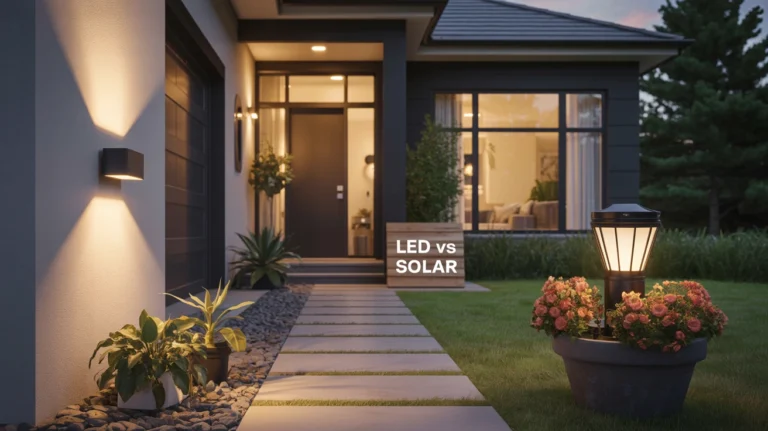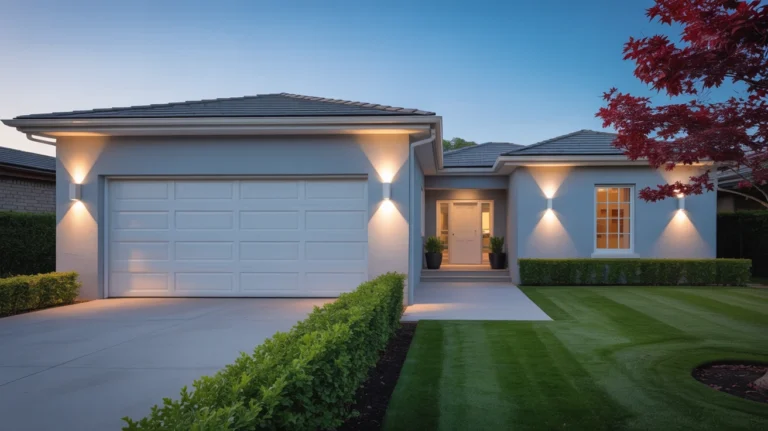How Solar Exterior House Lights Work
Solar exterior house lights provide an eco-friendly, cost-effective way to illuminate front porches, patios, pathways, and garages, enhancing curb appeal and safety without relying on grid electricity. In 2025, solar lighting is popular for its sustainability and ease of installation. This guide explains how solar exterior lights work, their components, benefits, and practical applications, featuring examples from brands like Amazon Basics, Linkind, and Brightech to light up your dream home.

How Solar Exterior House Lights Function
Solar lights harness sunlight to generate electricity, which powers LED bulbs for nighttime illumination. The process involves four key components working together:
1. Solar Panel (Photovoltaic Cell)
- Function: Converts sunlight into electricity via the photovoltaic effect. Photovoltaic cells, typically made of silicon, absorb photons from sunlight, creating an electric current.
- Details: Most solar lights use monocrystalline or polycrystalline panels for efficiency (15–20% energy conversion). Panels are sized to match the light’s power needs (e.g., 1–5 watts for small lights).
- Operation: Panels charge during daylight, requiring 6–8 hours of direct sunlight for optimal performance. South-facing placement maximizes exposure.
- Example: Amazon Basics Solar Pathway Lights (~$40, Amazon) use monocrystalline panels for reliable charging.
- Why It Matters: The panel is the power source, enabling grid-free operation.

2. Rechargeable Battery
- Function: Stores electricity generated by the solar panel for use at night.
- Details: Common batteries include NiMH (Nickel-Metal Hydride, 1.2V, 600–2000mAh) or Lithium-ion (3.7V, higher capacity). Batteries typically last 2–5 years before needing replacement.
- Operation: Charges during the day and discharges to power the light at night, providing 6–12 hours of illumination depending on charge and settings.
- Example: Linkind StarRay Solar Spotlight (~$30, Amazon) uses a lithium-ion battery for 8–12 hours of light.
- Why It Matters: Ensures consistent performance after sunset, even in cloudy conditions.

3. LED Bulb
- Function: Emits light using stored electricity, providing illumination for pathways, facades, or landscapes.
- Details: LEDs are used for their efficiency (80–100 lumens/watt) and longevity (25,000–50,000 hours). Output ranges from 10 lumens (decorative) to 650+ lumens (security).
- Operation: Activates at dusk via a photocell sensor, often with adjustable brightness or color settings (e.g., warm white, 2700K, or cool white, 5000K).
- Example: Brightech Ambience Pro Solar String Lights (~$40, Amazon) use warm white LEDs for cozy ambiance.
- Why It Matters: LEDs maximize light output while minimizing energy draw, extending battery life.

4. Controller and Sensors
- Function: Manages power flow and automates operation for efficiency.
- Details:
- Photocell Sensor: Detects ambient light to turn the light on at dusk and off at dawn.
- Motion Sensor (optional): Activates light only when movement is detected, saving battery (e.g., 10–33 feet range).
- Controller: Regulates charging and discharging to prevent battery overcharge or depletion.
- Operation: Ensures lights operate only when needed, optimizing energy use.
- Example: Amazon Basics Solar Wall Lantern (~$40, Amazon) includes a photocell and motion sensor for automated savings.
- Why It Matters: Automation reduces manual intervention and conserves power.

The Working Process
- Daytime Charging: The solar panel absorbs sunlight, converting it into electricity that charges the battery. A controller prevents overcharging.
- Dusk Activation: The photocell sensor detects low light, triggering the LED to turn on using stored battery power.
- Nighttime Illumination: The LED provides light for 6–12 hours, depending on battery capacity, sunlight received, and settings (e.g., motion-activated or continuous).
- Dawn Shutdown: The photocell sensor detects sunlight, turning off the LED to conserve battery and begin recharging.

Factors Affecting Performance
- Sunlight Exposure: 6–8 hours of direct sunlight is ideal; shaded or north-facing areas reduce charging efficiency.
- Weather: Cloudy or rainy days may limit charge, but modern batteries store enough for 1–2 nights.
- Season: Shorter winter days or lower sun angles may reduce runtime; adjustable panels help.
- Maintenance: Dust or debris on panels lowers efficiency; clean monthly with a damp cloth.
- Battery Health: Replace batteries every 2–5 years for optimal performance.

Benefits of Solar Exterior House Lights
- Cost Savings: Zero electricity costs; a 10W solar LED saves ~$3.29/year vs. a 10W grid-powered LED at $0.15/kWh (6 hours/day).
- Eco-Friendly: Reduces carbon footprint; no grid reliance lowers energy demand.
- Easy Installation: No wiring needed; stake or mount fixtures in minutes, saving ~$100–$300 vs. hardwired electrician costs.
- Versatility: Available as pathway lights, spotlights, wall lanterns, or string lights for light blue, gray, or white exteriors.
- Durability: IP65/IP67 ratings and corrosion-resistant materials (stainless steel, aluminum) withstand weather, ideal for coastal homes.
- Customer Quote: “Our solar lanterns save money and make our light gray house glow!” – Mark T., Central Iowa.

Types of Solar Exterior Lights and Applications
- Pathway Lights:
- Use: Line walkways or driveways for safety and aesthetics.
- Example: Amazon Basics Solar Pathway Lights (8-Pack), 10 lumens, ~$40, Amazon.
- Application: Enhances coastal or farmhouse curb appeal; pairs with light blue exteriors.
- Customer Quote: “The solar path lights guide guests to our beige home!” – Lisa M., Wilmington, NC.
- Spotlights:
- Use: Highlight facades, trees, or columns for architectural focus.
- Example: Linkind StarRay Solar Spotlight, 650 lumens, ~$30, Amazon.
- Application: Accents stonework or shrubs on white or navy homes.
- Customer Quote: “The spotlights make our sage green facade pop!” – Claire W., Denver, CO.
- Wall Lanterns:
- Use: Illuminate entryways or patios with elegant, functional light.
- Example: Amazon Basics Solar Wall Lantern (2-Pack), 200 lumens, ~$40, Amazon.
- Application: Complements modern or coastal homes with motion sensors.
- Customer Quote: “Our solar lanterns brighten our light blue porch effortlessly!” – Sarah M., Raleigh, NC.
- String Lights:
- Use: Create cozy ambiance for patios, decks, or pergolas.
- Example: Brightech Ambience Pro Solar String Lights, 100 lumens, ~$40, Amazon.
- Application: Enhances outdoor spaces on gray or beige homes.
- Customer Quote: “The string lights make our patio glow against our white house!” – Emily T., Seattle, WA.

Installation Tips
- Choose Sunny Locations: Place panels in areas with 6–8 hours of direct sunlight; avoid shade from trees or buildings.
- Orient Panels: Face panels south in the Northern Hemisphere for maximum sun exposure.
- Secure Fixtures: Stake pathway lights firmly; mount wall lanterns with included hardware.
- Test Placement: Run lights for 1–2 nights to confirm performance before permanent installation.
- Check Codes: Verify local regulations for outdoor lighting, especially for HOA communities.
Maintenance Tips
- Clean Panels: Wipe solar panels monthly with a damp cloth to remove dust, pollen, or salt.
- Check Batteries: Replace NiMH or lithium-ion batteries every 2–5 years (~$2–$10 each).
- Inspect Fixtures: Ensure IP65/IP67 seals remain intact; check for corrosion annually.
- Store in Winter: Remove and store lights in extreme cold to prolong battery life.
- Warranties: Use Amazon Basics (1 year), Linkind (1 year), or Brightech (3 years).
Where to Buy
- Amazon: Budget-friendly options like Amazon Basics, Linkind, and Brightech.
- Home Depot: Stocks Hampton Bay and other solar brands.
- Wayfair: Stylish solar lanterns and string lights.
- Manufacturer Sites: Direct purchases for warranties.
Customer Insights
- Sarah M., Raleigh, NC: “The solar wall lanterns are so easy to install and save us money on our light blue house!”
- Emily T., Seattle, WA: “Our solar string lights make our gray patio feel magical without a power bill!”
- Mark T., Central Iowa: “The solar spotlights highlight our navy facade and cost nothing to run!”
Conclusion
Solar exterior house lights work by converting sunlight into electricity via solar panels, storing it in batteries, and powering LED bulbs controlled by sensors. They save money with zero electricity costs, easy installation, and minimal maintenance while enhancing curb appeal and safety. Choose solar pathway lights, spotlights, lanterns, or string lights from Amazon Basics, Linkind, or Brightech for light blue, gray, or white exteriors. Shop at Amazon, Home Depot, or Wayfair, and follow installation tips for optimal performance. Share your solar lighting projects on Pinterest or Houzz to inspire others and illuminate your dream home sustainably!






